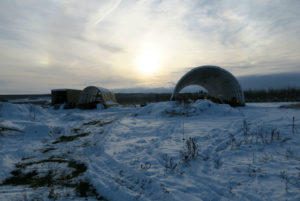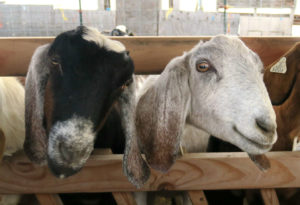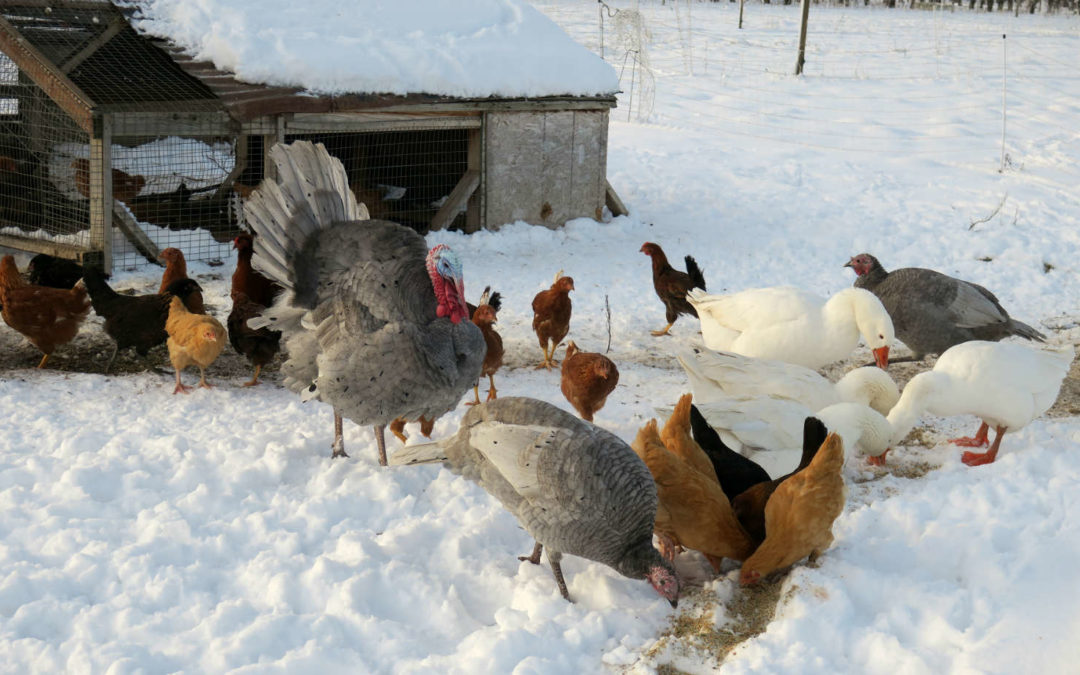Being an infrastructure nerd, I remember public works catastrophes. Ten years ago the City of Tieton, Washington‘s water system failed. Multiple water lines broke throughout the city. The State of Washington funded emergency repairs. The calamity was my first introduction to Tieton. Last summer, University of Washington held an alumni event in Tieton. Despite not going, I was intrigued and I still didn’t know where Tieton was. Last month, I bought delectable soft cheeses at the University District Farmers Market from Ruth and Lori Babcock, owners of Tieton Farm and Creamery. My curiosity was piqued. A Tieton trip was destined.

Tieton Farm & Creamery on a winter’s day
On a brisk December morning, after a significant Cascade Mountain snowfall, fellow adventure seeker Robbie and I ventured from the maritime Puget Sound to the frigid Washington interior. I-90 was still slick, but blue sky sucker holes lured us eastward. A Seattle ritual is an April trip to Yakima County to explore wineries and to climb treeless hillsides to be rewarded with commanding Mt. Rainier views, all while soaking in as much sunshine as possible. A winter visit is only for the hardy and properly clothed. We were prepared. Excitement around our adventure heightened as we climbed Naches-Tieton Road, 850 feet above the Yakima River Valley farms, to the Tieton Basin plateau.
The slow steady ascent on the sweeping road, hugging the slope’s rise, we finally entered through the final notch to the Tieton plateau. As a child, I was mesmerized by ever expanding vistas. Being on the brink of a slope and above a valley let me savor, even if for a brief moment, the views of what appears to be endless landscapes. A sense of calm, peace, and wonder pervades. There is a feeling smallness and at the same time immensity. A sense of awareness and possibility of something new, something exciting. My curiosity to explore was awakened again.
The plateau was bathed in mid-afternoon subdued light as we were only two weeks from the winter solstice. Mere inches of snow covered windswept farmland. We arrived at our destination, Tieton Farm & Creamery at 2:30 in the afternoon, just in time to help Ruth with the farm animals’ afternoon meal.
Ruth & Lori
Ruth grew up in Wenatchee in the heart of apple growing country, having worked summers picking fruit. After college, she landed in Seattle in the financial accounting software business, which demanded a lot of sitting time in front of a computer. Lori worked at the same company and had a passion for cooking. Ruth and Lori connected in the late 1990’s and dreamed about their future together.
I met Lori about the same time, when we served as Trustees together on the PCC Natural Markets Board. PCC Natural Markets is the nation’s largest natural foods grocery cooperative, founded in 1953, now with 12 stores throughout the Puget Sound region. PCC is more than just grocery store, as it sells high quality and sustainably grown food, some grown and produced by small independent farmers, such as Lori’s cheeses. Lori and I had forged a connection around the board table in our efforts to support the environment and ensure healthy, organic food without the additives, pesticides and fungicides for Puget Sound eaters.
Our time on the farm
Our farm chores took about one and a half glorious cold hours on the 20-acre property. The property, a former orchard, had been scourged by fire and in 2009 was a canvas ready to be painted by a new farmer. They got to work and now have 56 goats, 70 sheep, two pigs, a few cows and a steer, a couple of horses, and a flock of fowl including geese, turkeys, ducks, and chickens. All had to be fed and given water.
We met the goats first: Sonnet, Black Pearl, Rheba, and more. All named for their temperament–living in a large, new, open-ended hoop barn, since the older barn had been destroyed by an electrical fire the previous year. Eastern Washingtonians must always be vigilant around fire as their land is susceptible to summer and early fall fire threats, because it is so dry with only nine inches of yearly rainfall. The 2015 wildfire season was the worst in Washington’s history with 1,600 square miles burned (almost the same size as Pierce County’s land area)!

Patiently waiting goats
The goats with expecting looks on their faces waited patiently, as we filled the troughs. All 56 goats lined-up along the trough, as orderly kindergartens do before heading to the lunchroom. In December, all the animals are in their dry period or non-lactating cycle, when they stop producing milk prior to the next birthing and milking season. This cycle is totally normal and likely unbeknownst to the common eater, including me! Not having milking responsibilities consuming six hours daily created a perfect time for our visit. During peak season, with 90 animals to milk, farm days are long with endless farm duties of feeding, cleaning, milking, rotating fencing, and irrigating. Thankfully, there are plenty of daylight hours. In the milking season, electric fencing is rotated every three days to ensure fresh forage for the animals and to limit manure build-up in the fields. Monthly fence rotations are only needed in the winter, as the animals are farmer fed.

Robbie Petting the Pigs
Next stop–the pigs–which are raised for pasture-raised pork products. Grain was scooped from a large barrel and sprinkled on the ground. We called for the pigs, but no pigs. Finally, the pigs braved the cold and moseyed out of their hovel for affection first and dinner second. Each animal grouping has their own fenced area and a water trough. With frigid temperatures, most troughs have a small electric heater element to ensure water and not ice is available to drink. The pigs used to confiscate their heater for hut warmth. Those pesky pigs outsmart the farmer! Now hot water is carried to the pig’s water bowl to ensure winter liquid refreshment!

Farmer Ruth Poised to Feed the Sheep
The cows and sheep are fed organic hay, purchased for winter feedings. With herd mentality, the sheep watched and followed our every move, as we peeled off “flakes” or about a three-inch thick square section of hay bale to toss into the pen. A five sheep group ate three flakes of hay. Two tips for hay heaving, never aim for a manure pile and always use a side arm throw rather than over head toss. Being dressed in grass flecks confirmed I was a novice thrower.
All the fowl are cooped together with both inside and outside space. Grain was sprinkled in a make-shift snow trough. The chickens immediately started eating while the turkeys and geese took their time preening themselves before deciding it was time to eat. In each animals’ pen, we refilled the drinking trough with a garden hose. The hose was quickly drained by lifting the hose from one end to the other to ensure an empty hose. Frozen cracked hoses are useless.
Cheese-making
Lori makes the finest artisanal cheeses–the soft cheeses Bianca, Sonnet, Black Pearl, and Rheba are named after the goats–using pasteurized milk as required by law. The hard cheeses, Venus and Calypso are made using unpasteurized raw milk. My favorite is Rheba, as it has a Camembert consistency with sharp overtones. But, why do the soft cheeses need to be pasteurized?
Pasteurization was a technology breakthrough in the mid-19th century by Louis Pasteur’s to heat liquids to kill bacteria, whether wanted or unwanted. Cheese can be made with raw milk, provided it is aged more than 60 days. Raw milk aficionados contend there are beneficial microbes that not only add superior flavor and complexity to cheese, but perhaps may even help humans with more robust belly flora. Harmful bacteria, such as listeria, can harbor in milk products when animals are kept in dirty, confinement conditions and the udders are not properly cleaned and treated, prior to milking. The 60-day aging rule was established in 1949 as the minimum cutoff date when the acids and salts in the cheese making process would destroy any harmful bacteria in raw milk. Visiting the farm, and observing the intensity, dedication, and attentiveness that Ruth has for the animals’ health and well-being brings utter (or is it “udder”) confidence in the cheese products that Lori creates.
The life of a farmer varies in pace from winter to summer, and in the different cycles of the animals. With attentiveness, knowledge, and love, Ruth ensures happy and healthy animals to produce the finest milk, cheese, and meat products. As with Ruth, Lori’s cheeses vary with the seasons. The artisanal ingenuity is evident in the rhythm and care of the farm and the flavor of the cheese. Now visiting Tieton is a “must-do” on an April jaunt for sunshine and perhaps for the Mighty Tieton spring open house!
Kathryn Gardow, P.E., is a local food advocate, land use expert and owner of Gardow Consulting, LLC, an organization dedicated to providing multidisciplinary solutions to building sustainable communities. Kathryn has expertise in project management, planning, farmland conservation, and civil engineering, with an emphasis on creating communities that include food production. Kathryn’s blog muses on ways to create a more sustainable world and good food!


This article was very engaging, drescriptive and personal! In fact, your article reminded me of some of the writing that appears in the “Edible Seattle” magazine. I recommend submitting this article (as well as the flooding article) to the editor!